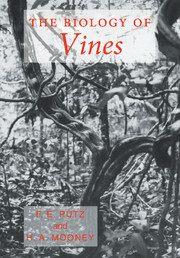Book contents
- Frontmatter
- Contents
- List of contributors
- Foreword
- Preface
- Acknowledgements
- I INTRODUCTION
- II CLIMBING MECHANICS AND STEM FORM
- III VINE PHYSIOLOGY AND DEVELOPMENT
- 5 Water flux and xylem structure in vines
- 6 Reserve economy of vines
- 7 Photosynthesis and gas exchange of vines
- 8 Heteroblastic development in vines
- 9 Physiological ecology of mesic, temperate woody vines
- 10 Secondary compounds in vines with an emphasis on those with defensive functions
- IV COMMUNITY ECOLOGY OF VINES
- V ECONOMIC IMPORTANCE OF VINES
- Taxonomic index
- General index
6 - Reserve economy of vines
Published online by Cambridge University Press: 05 November 2011
- Frontmatter
- Contents
- List of contributors
- Foreword
- Preface
- Acknowledgements
- I INTRODUCTION
- II CLIMBING MECHANICS AND STEM FORM
- III VINE PHYSIOLOGY AND DEVELOPMENT
- 5 Water flux and xylem structure in vines
- 6 Reserve economy of vines
- 7 Photosynthesis and gas exchange of vines
- 8 Heteroblastic development in vines
- 9 Physiological ecology of mesic, temperate woody vines
- 10 Secondary compounds in vines with an emphasis on those with defensive functions
- IV COMMUNITY ECOLOGY OF VINES
- V ECONOMIC IMPORTANCE OF VINES
- Taxonomic index
- General index
Summary
Introduction
The principal advantage of the vine growth form is the potential for rapid growth rate. Carbon that would otherwise go into supporting stem tissue can go into leaves, thus yielding a compounding of the growth increment (Monsi & Murata, 1970). Although the difference in stem allocation between vines and other plants is clear, what has not been well documented is the proportional allocation of carbon and other resources in vines to nonproductive compounds and structures, including roots, compared to other growth forms. Here we examine at least a part of the area by focusing on the pool sizes and utilization patterns of storage reserves in various vine species.
Why should we expect vining plants to have different storage cycles from self-supporting plants in the same habitat? Trees and shrubs often store much of their reserves of water, carbohydrates, and nutrients within the massive stem. As a consequence of the vine growth form, vines have much less stem-to-leaf mass than do self-supporting plants, and so may require specialized sites in which to store reserves, and cycles to deposit and withdraw these reserves. If the vining strategy results in greater risk of physical injury than other growth strategies, as discussed by Fisher & Ewers (Chapter 4), then vines may benefit from having greater energy stores for repair and regrowth than trees. In the case of herbaceous perennials that die back during the unfavorable period, vines may rely upon their stored reserves to regain quickly the canopy position before deterioration of the light climate due to leaf out by over story trees.
- Type
- Chapter
- Information
- The Biology of Vines , pp. 161 - 180Publisher: Cambridge University PressPrint publication year: 1992
- 3
- Cited by

